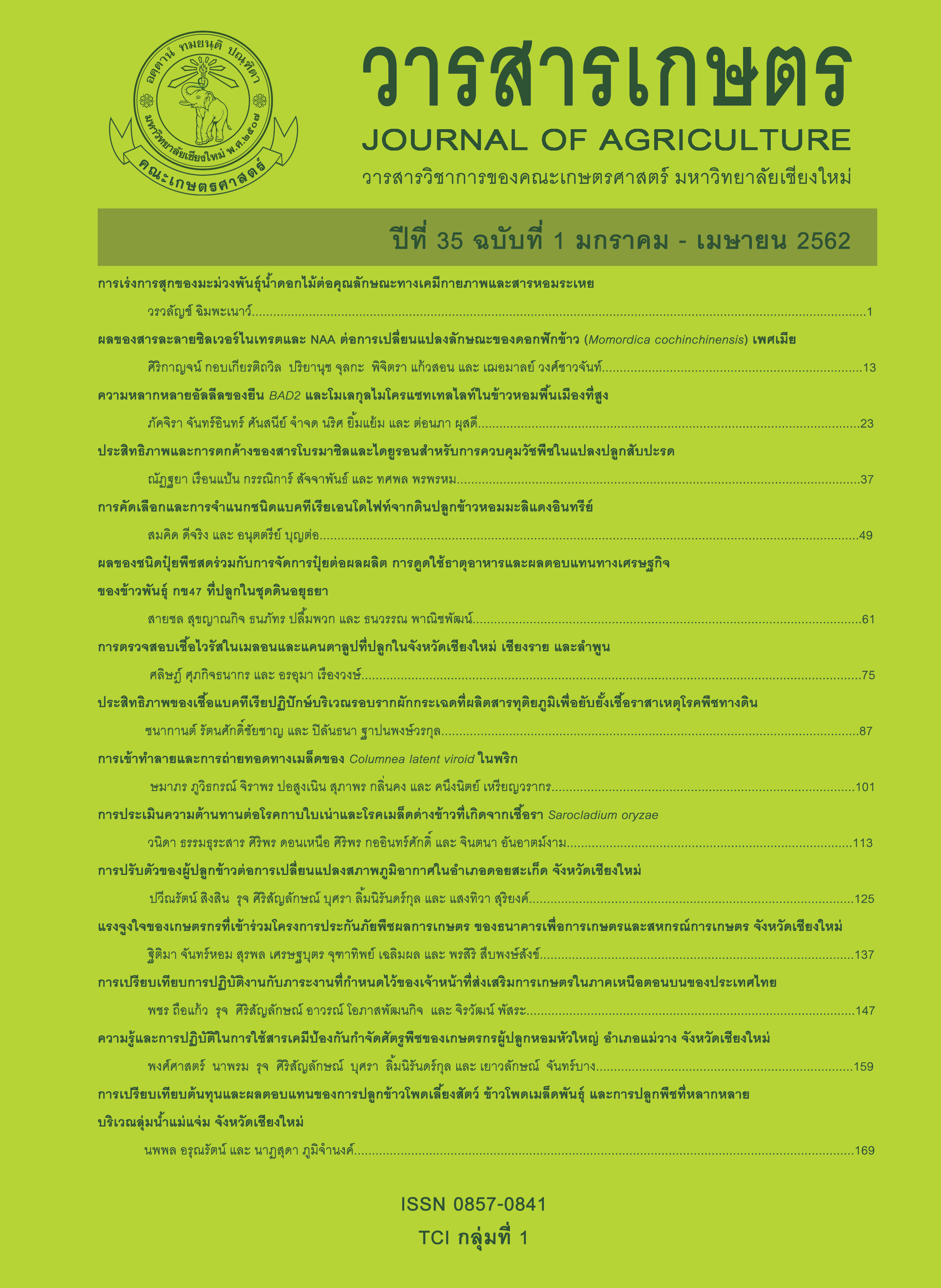ประสิทธิภาพของเชื้อแบคทีเรียปฏิปักษ์บริเวณรอบรากผักกระเฉดที่ผลิตสารทุติยภูมิเพื่อยับยั้งเชื้อราสาเหตุโรคพืชทางดิน
Main Article Content
บทคัดย่อ
การศึกษานี้มีวัตถุประสงค์เพื่อคัดเลือกเชื้อแบคทีเรียปฏิปักษ์บริเวณรอบรากผักกระเฉดที่มีศักยภาพยับยั้งการเจริญเส้นใยของเชื้อราสาเหตุโรคพืชทางดิน ได้แก่ Sclerotium rolfsii, Rhizoctonia solani, Pythium sp. และ Fusarium oxysporum สาเหตุโรครากเน่าโคนเน่าของผักสลัด เมื่อทำการทดสอบด้วยวิธี dual culture และผลการยับยั้งเชื้อราสาเหตุโรคพืชโดยสารระเหย (volatiles) ด้วยวิธี sealed plate พบว่า เชื้อแบคทีเรีย จำนวน 10 ไอโซเลท คือ R1016, R1029, R1033, R1036, J3002, Rr4007, Rr4053, Rr4058, Rr4082 และ Rr4084 สามารถยับยั้งเชื้อราสาเหตุโรคทางดินทั้ง 4 ชนิดได้ และผลของสารระเหยของเชื้อแบคทีเรียทั้ง 10 ไอโซเลท ต่อการยับยั้งการเจริญของเชื้อราสาเหตุโรค พบว่า สามารถยับยั้งการเจริญเส้นใยของเชื้อราได้ทุกชนิด ซึ่งแตกต่างอย่างมีนัยสำคัญทางสถิติ (P<0.05) โดยมีเปอร์เซ็นต์การยับยั้งเชื้อรา S. rolfsii และ Pythium sp. สูงสุดอยู่ในช่วง 75-100 เปอร์เซ็นต์ รองลงมาคือ เชื้อรา R. solani มีเปอร์เซ็นต์การยับยั้งสูงสุดอยู่ในช่วง 53-57 เปอร์เซ็นต์ และเชื้อรา F. oxysporum มีเปอร์เซ็นต์การยับยั้งได้สูงสุด 12 เปอร์เซ็นต์ นอกจากนี้ ผลของสารระเหยที่ผลิตจากเชื้อแบคทีเรียบางไอโซเลท ทำให้เส้นใยมีลักษณะผิดปกติ และส่งผลกระทบต่อปริมาณการเจริญของเส้นใยบนอาหาร potato dextrose agar (PDA) พบ 5 ไอโซเลท ได้แก่ R1033, Rr4053, Rr4058, Rr4082 และ Rr4084 สามารถยับยั้งการเจริญเส้นใยของเชื้อรา S. rolfsii ได้อย่างมีประสิทธิภาพ เมื่อนำเส้นใยย้ายไปวางบนอาหาร PDA เชื้อไม่สามารถเจริญได้ อีกทั้งเชื้อแบคทีเรียปฏิปักษ์บางไอโซเลทสามารถสร้างสารทุติยภูมิได้ กล่าวได้ว่า สารระเหยและสารทุติยภูมิมีบทบาทสำคัญในการควบคุมโรคโดยชีววิธี การศึกษานี้เป็นแนวทางการใช้สารระเหยที่ผลิตจากเชื้อแบคทีเรียปฏิปักษ์เพื่อควบคุมโรครากเน่าโคนเน่าและส่งเสริมการเจริญของพืช
Article Details
References
ปิลันธนา ฐาปนพงษ์วรกุล และ ชนากานต์ รัตนศักดิ์ชัย-ชาญ. 2559. ประสิทธิภาพของน้ำสกัดชีวภาพจากเศษเหลือพริกต่อการยับยั้งเชื้อรา Colletotrichum gloeosporioides ในสภาพห้องปฏิบัติการ. วารสารเกษตร 32(1): 61-72.
ปิลันธนา ฐาปนพงษ์วรกุล และ ศราวิชญ์ สายมงคล. 2558. ประสิทธิภาพของเชื้อแบคทีเรียปฏิปักษ์ Bacillus megaterium สายพันธ์ No.16 ในการควบคุมโรคกาบใบแห้งของข้าวพันธุ์ กข6. วารสารเกษตร 31(3): 301-310.
มานะ กาญจนมณีเสถียร อัจฉรา เพ็งหนู ฤดีกร วิวัฒน-ปัฐพี และ วานิด รอดเนียม. 2556. การคัดเลือกแบคทีเรียปฏิปักษ์และการพัฒนาผลิตภัณฑ์แบคทีเรียปฏิปักษ์เพื่อควบคุมโรคพืชที่ปลูกในระบบไฮโดรโพนิกส์. สถาบันวิจัยและพัฒนามหาวิทยาลัยศิลปากร, นครปฐม. 58 หน้า.
Agrios, G.N. 2005. Plant Pathology. 5th ed. Academic Press, New York. 592 p.
Alstrom, S. 2001. Characteristics of bacteria from oilseed rape in relation to their biocontrol activity against Verticillium dahliae. Journal of Plant Pathology 149(2): 57-64.
Antoun, H., C.J. Beauchamp, N. Goussard, R. Chabot and R. Lalande. 1998. Potential of Rhizobium and Bradyrhizobium species as plant growth promoting rhizobacteria on non-legumes: Effect on radishes (Raphanus sativus L.). Plant and Soil 204(1): 57-67.
Arfaoui, A., B. Sifi, A. Boudabous, I.E. Hadrami and M. Chérif. 2006. Identification of Rhizobium isolates possessing antagonistic activity against Fusarium oxysporum f. sp. ciceris, The causal agent of fusarium wilt of chickpea. Journal of Plant Pathology 88(1): 67-75.
Astrom, B. and B. Gerhardson. 1988. Differential reactions of wheat and pea genotypes to root inoculation with growth-affecting rhizosphere bacteria. Plant and Soil 109(2): 263-269.
Bardin, S.D., H.C. Huang, J. Pinto, E.J. Amundsen and R.S. Erickson. 2004. Biological control of Pythium damping-off of pea and sugar beet by Rhizobium leguminosarum bv. viceae. Canadian Journal of Botany 82(3): 291-296.
Bhatia, S., R.C. Dubey and D.K. Maheshwari. 2005. Enhancement of plant growth and suppression of collar rot of sunflower caused by Sclerotium rolfsii through fluorescent Pseudomonas. Indian Phytopathology 58(1): 17-24.
Burr, T.J., B.H. Katz, A.L. Bishop, C.A. Meyers and V.L. Mittak. 1988. Effect of shoot age and tip culture propagation of grapes on systemic infestations by Agrobacterium tumefaciens biovar 3. American Journal of Enology and Viticulture 39: 67-70.
Calvo, P., E. Ormeño-Orrillo, E. Martínez-Romero and D. Zúñiga. 2010. Characterization of Bacillus isolates of potato rhizosphere from Andean soils of Peru and their potential PGPR characteristics. Brazilian Journal of Microbiology 41(4): 899-906.
Chaurasia, B., A. Pandey, L.M. S. Palni, P. Trivedi, B. Kumar and N. Colvin. 2005. Diffusible and volatile compounds produced by an antagonistic Bacillus subtilis strain cause structural deformations in pathogenic fungi in vitro. Microbiological Research 160(1): 75-81.
Deshwal, V.K., P. Pandey, S.C. Kang and D.K. Maheshwari. 2003. Rhizobia as a biological control agent against soil borne plant pathogenic fungi. Indian Journal of Experimental Biology 41(10): 1160-1164.
Ekman, J., L. Tesoriero and S. Grigg. 2014. Pests, Diseases and Disorders of Babyleaf Vegetables: A Field Identification Guide. Applied Horticultural Research, New South Wales.114 p.
Fernando, W.G.D. and R.G. Linderman. 1995. Inhibition of Phytophthora vignae and stem and root rot of cowpea by soil bacteria. Biological Agriculture and Horticulture 12(1): 1-14.
Fiddaman, P.J. and S. Rossall. 1993. The production of antifungal volatiles by Bacillus subtilis. Journal of Applied Microbiology 74(2): 119-126.
Fiddaman, P.J. and S. Rossall. 1994. Effect of substrate on the production of antifungal volatiles from Bacillus subtilis. Journal of Applied Microbiology 76(4): 395-405.
Harman, G.E., C.R. Howell, A. Viterbo, I. Chet and M. Lorito. 2004. Trichoderma species: opportunistic, avirulent plant symbionts. Nature Reviews Microbiology 2(1): 43-56.
Homma, Y., Z. Sato, F. Hirayama, K. Konno, H. Shirahama and T. Suzui. 1989. Production of antibiotics by Pseudomonas cepacia as an agent for biological control of soilborne plant pathogens. Soil Biology and Biochemistry 21(5): 723-728.
Kai, M., U. Effmert, G. Berg and B. Piechulla. 2007. Volatiles of bacterial antagonists inhibit mycelial growth of the plant pathogen Rhizoctonia solani. Archives of Microbiology 187(5): 351-360.
Khianngam, S., Y. Pootaeng-on, T. Techakriengkrai and S. Tanasupawat. 2014. Screening and identification of cellulase producing bacteria isolated from oil palm meal. Journal of Applied Pharmaceutical Science 4(4): 090-096.
Kurze, S., H. Bahl, R. Dahl and G. Berg. 2001. Biological control of fungal strawberry diseases by Serratia plymuthica HRO-C48. Plant Disease 85(5): 529-534.
Nelson, E.B., W.L. Chao, J.M. Norton, G.T. Nash and G.E. Harman. 1986. Attachment of Enterobacter cloacae to hyphae of Pythium ultimum: possible role in the biological control of Pythium preemergence damping-off. Phytopathology 76(3): 327-335.
Richard, N.R. 2004. Lettuce diseases and their management. pp. 121-147. In: S.A.M.H. Naqvi (ed.). Diseases of Fruits and Vegetables. Vol. 2. Springer, Dordrecht.
Tenorio-Salgado, S., R. Tinoco, R. Vazquez-Duhalt, J. Caballero-Mellado and E. Perez-Rueda. 2013. Identification of volatile compounds produced by the bacterium Burkholderia tropica that inhibit the growth of fungal pathogens. Bioengineered 4(4): 236-243.
Van Loon, L.C., P.A.H.M. Bakker and C.M.J. Pieterse. 1998. Systemic resistance induced by rhizosphere bacteria. Annual Review of Phytopathology 36: 453-483.
Wheatley, R.E. 2002. The consequences of volatile organic compound mediated bacterial and fungal interactions. Antonie Van Leeuwenhoek 81: 357-364.

